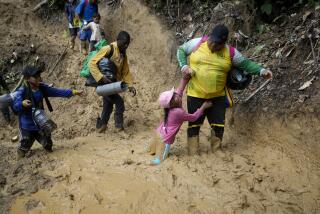War, Poverty Drive Afghan Children Into Work Force
- Share via
MAZAR-I-SHARIF, Afghanistan — Khair Muhammad, who says he’s 10 -- “maybe” -- sits on the floor working amid the noise and toxic smells of a workshop at the Sherzad Plastic Factory.
He expertly cuts excess material from molded water pitchers with a small knife held by equally small hands stained red by dye.
For his 10 1/2 hours of labor, Khair will earn 13,000 Afghanis -- about 20 cents. His six-day week will bring in $1.20.
But that sum will help support his family of eight, struggling to survive because the children’s father is too old to work. “We don’t have anything to eat at home, so I have to work to earn money,” says Khair, who has a firm handshake learned from two years on the job.
More than 2,000 children are working in the northern city of Mazar-i-Sharif, plus thousands more throughout the country, said Robert Ffolkes, head of Afghan operations of Save the Children, a British charity.
Drought, war and a long history of poverty make child laborers a vital part of the economy.
“I don’t think you can stop it,” Ffolkes said. “They can’t afford not to work, and their families can’t afford for them not to work.”
The problem is particularly acute in Afghanistan because the Taliban didn’t allow women to work and augment their families’ incomes, said Martha Bragin, a child protection consultant with UNICEF.
At the Sherzad factory, owner Ramatullah Sherzad says 800 of his 1,000 workers are under age 18. He says his youngest is 13 -- although Khair standing nearby is clearly younger.
Sherzad says he made no special effort to recruit child laborers. “They have money problems and they have to work here,” he says. “We don’t bring them here -- they come to us.”
Besides wages, the workers get two meals a day: bread with tea and sugar for breakfast, and beans for lunch.
Among the products the factory makes are small water pitchers with the word “Titanic” and a teddy bear printed on them, a product Sherzad says resulted from requests by children who saw the hit movie.
Friday, his day off, aren’t much of a break for Khair. He can’t name any game he likes to play. He says he enjoys bringing his family water. He can’t read.
Child laborers like Khair aren’t hard to find here.
In a sweltering, cramped room piled to the ceiling with firewood, 14-year-old Sadiq is rocking a cauldron in a circle to sugarcoat peanuts and make noqol, an Afghan sweet. He attended school up to third grade, but as the oldest in his family, he dropped out and went to work. His father is a farmer, but he has been unable to make a living the last few years because of the drought.
More to Read
Sign up for Essential California
The most important California stories and recommendations in your inbox every morning.
You may occasionally receive promotional content from the Los Angeles Times.













